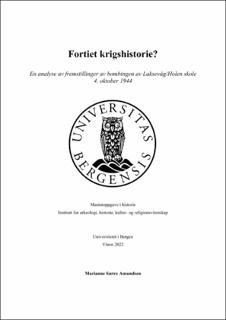| dc.description.abstract | This master thesis is a study of how the bombing of Laksevåg/Holen school 4th of October 1944 has been portrayed and commemorated. The issue to be addressed is: In which ways has the bombing of Laksevåg/Holen school been portrayed, by whom, and what can explain the various representations? The issue includes research questions related to an alleged concealment of the incident. A main objective has been to find and explain the development of the local war history at Laksevåg, specifically of the bombing 4th of October. On a more general level, the objective has been to acquire knowledge about the national writing of World War II history in Norway. At an overall level, the thesis has been designed to gain insight into remembrance and memory culture related to World War II and traumatic events in general. The method used to address the issue is text analysis, which includes close reading and contextualization. The analysis is based on a vast material of textual representations from 1944 to 2022, consisting of several professional historical works, both of local history and national war history, newspapers, memorial works, fictional booksand other genres. The theoretical framework for the analysis is the history didactical concept of uses of history, specifically Klas-Göran Karlsson's typology, and Quentin Skinners conceptualization of speech act theory. The analysis focuses on three periods, and several patterns of representation have been identified in each of them. Chapter 2 concerns the period from 1944-1970. Apart from the Nazi-controlled newspapers in 1944, the portrays from this period is characterized by patterns of cognition, reconciliation and justification of the incident. Chapter 3 covers the second period, from 1970-1990, where new patterns emerge, characterized by nuances, speculations and guilt attribution. Chapter 4 concerns the last period, from 1990-2022. During this period, several debates and discussions arose, and the main pattern is highlighting of the long-term victims of the bombing, as well as demands for recognition of their experiences and struggles. The thesis argues that the bombing of Laksevåg/Holen school itself, has not been concealed. The conclusion points to several explanations behind the allegations of concealment, including a lack of recognition of the survivors’ traumas. | |
